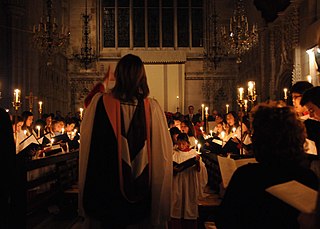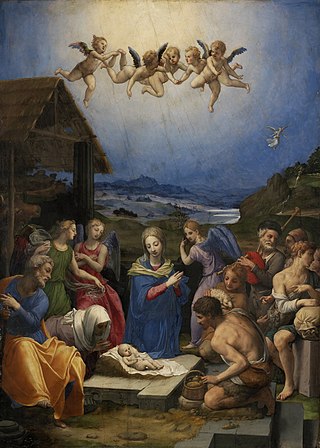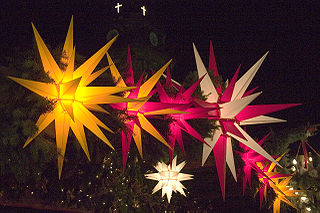Related Research Articles

A Christmas carol is a carol on the theme of Christmas, traditionally sung at Christmas itself or during the surrounding Christmas holiday season. The term noel has sometimes been used, especially for carols of French origin. Christmas carols may be regarded as a subset of the broader category of Christmas music.
This article is about music-related events in 1836.

Nine Lessons and Carols, also known as the Festival of Nine Lessons and Carols and Service of Nine Lessons and Carols, is a service of Christian worship traditionally celebrated on or near Christmas Eve. The story of the fall of humanity, the promise of the Messiah, and the birth of Jesus is told in nine short Bible readings or lessons from Genesis, the prophetic books and the Gospels, interspersed with the singing of Christmas carols, hymns and choir anthems.

The colonial history of the United States began in 1607 with the colonization of Jamestown, Virginia. Music of all genres and origins emerged as the United States began to form. From the Indigenous spiritual music to the African banjos, music in the United States is as diverse as its people. In New England, the music was very religious and was vitally important in the rising of American music. The migration of people southward led to the settling of the Appalachian Mountains. There many poor Europeans inhabited and brought country blues and fiddling. As music spread, the religious hymns were still just as popular. The first New England School, Shakers, and Quakers, which were all music and dance groups inspired by religion, rose to fame. In 1776, St. Cecilia Music Society opened in the Province of South Carolina and led to many more societies opening in the Northern United States. African slaves were brought to the United States and introduced the music world to instruments like the xylophone, drums and banjo. The diverse music of the United States comes from the diverse type of people who first colonized this country.

John Milford Rutter is an English composer, conductor, editor, arranger, and record producer, mainly of choral music.
"Joy to the World" is an English Christmas carol. The carol was written in 1719 by the English minister and hymnwriter Isaac Watts, and its lyrics are an interpretation of Psalm 98 celebrating the birth of Jesus Christ. Today, the carol is usually sung to an 1848 arrangement by the American composer Lowell Mason.

Anglican church music is music that is written for Christian worship in Anglican religious services, forming part of the liturgy. It mostly consists of pieces written to be sung by a church choir, which may sing a cappella or accompanied by an organ.

"We Three Kings", original title "Three Kings of Orient", also known as "We Three Kings of Orient Are" or "The Quest of the Magi", is a Christmas carol that was written by John Henry Hopkins Jr. in 1857. At the time of composing the carol, Hopkins served as the rector of Christ Episcopal Church in Williamsport, Pennsylvania, and he wrote the carol for a Christmas pageant in New York City. It was the first widely popular Christmas carol written in America.

"Hark! The Herald Angels Sing" is an English Christmas carol that first appeared in 1739 in the collection Hymns and Sacred Poems. The carol, based on Luke 2:14, tells of an angelic chorus singing praises to God. As it is known in the modern era, it features lyrical contributions from Charles Wesley and George Whitefield, two of the founding ministers of Methodism, with music adapted from "Vaterland, in deinen Gauen" by Felix Mendelssohn.

"Away in a Manger" is a Christmas carol first published in the late nineteenth century and used widely throughout the English-speaking world. In Britain, it is one of the most popular carols; a 1996 Gallup Poll ranked it joint second. Although it was long claimed to be the work of German religious reformer Martin Luther, the carol is now thought to be wholly American in origin. The two most common musical settings are by William J. Kirkpatrick (1895) and James Ramsey Murray (1887).
"The Spirit of God Like a Fire Is Burning" is a hymn of the Latter Day Saint movement. It was written by W. W. Phelps, one of the most prolific hymnwriters of early Mormonism.
Hosanna is a liturgical word in Judaism and Christianity. In Judaism it refers to a cry expressing an appeal for divine help. In Christianity it is used as a cry of praise.

Sunrise service is a worship service on Easter Sunday practiced by some Christian denominations, such as the Moravian Church.
Hymns are an important part of the history and worship of the Church of Jesus Christ of Latter-day Saints.

"O come, O come, Emmanuel" is a Christian hymn for Advent, which is also often published in books of Christmas carols. The text was originally written in Latin. It is a metrical paraphrase of the O Antiphons, a series of plainchant antiphons attached to the Magnificat at Vespers over the final days before Christmas. The hymn has its origins over 1,200 years ago in monastic life in the 8th or 9th century. Seven days before Christmas Eve monasteries would sing the “O antiphons” in anticipation of Christmas Eve when the eighth antiphon, “O Virgo virginum” would be sung before and after Mary’s canticle, the Magnificat. The Latin metrical form of the hymn was composed as early as the 12th century.

A Moravian star is an illuminated Advent, Christmas, or Epiphany decoration popular in Germany and in places in Europe and America where there are Moravian congregations, notably the Lehigh Valley of Pennsylvania and the area surrounding Winston-Salem, North Carolina. The stars take their English name from the Moravian Church, originating in Moravia. In Germany, they are known as Herrnhut stars, named after the Moravian Mother Community in Saxony, Germany, where they were first commercially produced.

The Moravian musical tradition in United States began with the earliest Moravian settlers in the first half of the 18th century.
These Moravians were members of a well-established church – officially called Unitas Fratrum or Unity of Brethren – that by [the mid-18th century] had already seen almost three centuries of rich experience of religious life. They were spiritual descendants of the Czech priest Jan Hus, who for his attempts at reform was martyred in 1415. Forty-two years later in 1457, some of his followers founded a church body consecrated to following Christ in simplicity and dedicated living.
This newly constituted church developed a rich and orderly ecclesiastical life in the 15th and 16th centuries, but in the Thirty Years War of 1618-48 it was virtually wiped out. In the 1720s a few exiles of this religious heritage, along with various other seekers after truth, found refuge on an estate of a Saxon nobleman named Nicholaus Ludwig von Zinzendorf. There in their village of Herrnhut the ancient church experienced a rebirth culminating in a spiritual blessing on August 13, 1727, in which their former diversity of purpose was welded into one.
In a brief five years, by 1732, that first little village of the Renewed Moravian Church began sending missionaries to all corners of the world. After establishing work in England, the Moravians sent colonists to America in 1735. The initial settlement in Georgia proved unsuccessful, partly because of war between Protestant England and Catholic Spain to the south in Florida. More permanent work was established in Pennsylvania in 1741, with the town of Bethlehem as their chief center. Other settlements in Pennsylvania followed. The Moravians purchased 100,000 acres in North Carolina and settled at Bethabara in 1753 with the central town of Salem being founded in 1766.” [Villages of the Lord]
Francis Florentine Hagen (1815–1907) was a Moravian minister and composer. He is best known for his hymn "Morning Star" (1836) that is typically sung on Christmas Eve.
"Ermuntre dich, mein schwacher Geist" is a German Christmas carol with lyrics by Johann Rist and a melody by Johann Schop, first published in 1641. Historically it was contained in Protestant hymnals, but the current one, Evangelisches Gesangbuch, uses only three of its stanzas, the ninth, the second and the twelfth, titled "Brich an, du schönes Morgenlicht". This stanza was used by Johann Sebastian Bach as a chorale in Part II of his 1734 Christmas Oratorio.

Christmas traditions include a variety of customs, religious practices, rituals, and folklore associated with the celebration of Christmas. Many of these traditions vary by country or region, while others are practiced in a virtually identical manner across the world.
References
- ↑ June C. Montgomery, Kenon D. Renfrow Stories of the Great Hymns: Short Sessions on the Creation ... 1457414570- Page 13 Morning Star Hymn tune names Melita Lux Benigna St. Agnes Beatitndo "
- ↑ William D. Crump The Christmas Encyclopedia 3d ed.: 2001 -- Page 298 1476605734 "At some point in the service, it is customary for a child to sing two lines of the Moravian hymn “Morning Star,” whereupon the congregation antiphonally repeats these lines, and all sing the final line in unison. The lyrics to “Morning Star” were ..."
- ↑ Nancy Smith Thomas Moravian Christmas in the South - Page 54 - 2007 "The memorable hymn "Morning Star," with music composed by Salem native Francis Hagen, is believed to have been performed for the first time on Christmas Eve 1836 in Salem. No one who has ever attended a Christmas lovefeast ..."
- ↑ Nola Reed Knouse The Music of the Moravian Church in America 2008 - Page 183 "Hellström included a brass quartet in his adaptation of the popular Moravian Christmas hymn Morning Star. Conclusion Since its origins in Herrnhut around 1730, brass music has become an important institution within the Moravian Church."
- ↑ Paul F. Bradshaw - New SCM Dictionary of Liturgy and Worship 2013 - Page 112 0334049326 "After readings, recitations and carols, each child receives a lighted candle. The children process with them round the darkened church, and the service ends with the hymn 'Morning star, 0 cheering sight!' Since 1968 the Anglican charity, The ..."